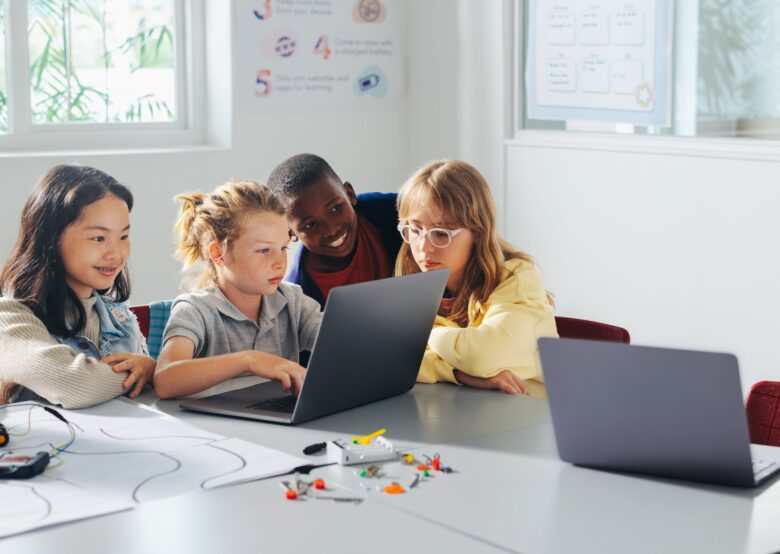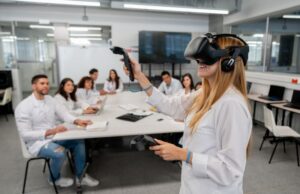The classroom is no exception to the fast-changing technology in today’s world. Teachers no longer have to rely on textbooks and chalkboards. Ed Tech (education technology) offers many ways to engage students, deliver lessons, and assess them. It’s not just about using new tools to enhance your curriculum. It’s all about improving the effectiveness, personalization, and connection to real life of teaching. These changes are being embraced by schools around the globe, and a thoughtful integration of these changes is key to success in the long term.
Understanding Your Educational Goals First
It’s crucial to know what you hope to achieve through your curriculum before choosing EdTech tools. Each class has different learning objectives, and technology should be used to support these goals. Knowing your goal will help you select the best tools, whether you want to improve student interaction, make lessons interactive, or provide better feedback. Technology becomes an asset when it is used to achieve educational goals, rather than as a distraction. This ensures technology is used as a tool and not just an accessory.
Choose the Right Tools for Your Classroom
It can be difficult to choose which EdTech tools to use. Each tool, from interactive whiteboards and learning management systems to digital assessment platforms, has its own advantages. It is important to choose tools that best suit the learning styles and requirements of your students. Others may prefer audio content or digital simulations, while some may prefer visual content. The best tools for a classroom with a variety of students are those that offer flexibility and customization. The right technology can make learning more engaging, accessible, and meaningful.
Teachers are Trained to Use Technology Effectively
Teachers must know how to properly use technology for it to be useful. Teacher training is crucial when integrating EdTech into the curriculum. Teachers need time to learn about new tools, use them, and plan lessons. Teachers who are confident about their technology skills can spend more time on teaching and less time on troubleshooting. To help teachers become more comfortable with Ed Tech, schools should invest in tutorials, professional development sessions, and peer mentoring programs. A teacher who is well-trained can make a huge difference when it comes to transforming tech into an effective learning tool.
Blended Learning Environment
Blended learning combines face-to-face learning with digital tools in order to improve the learning experience. Teachers can take advantage of the best of both worlds with this method. Students can still participate in lectures and discussions, but they also have online access to digital resources, interactive exercises, and videos. This balance encourages active participation and personalizes learning. Blended learning allows students to review material outside of class, ask more questions in the classroom, and apply knowledge both online and off.
Encourage Student-centered Learning
Ed tech allows a shift away from teacher-centered teaching to student-centered education. In a classroom that is student-centered, students take greater responsibility for their own education. Students set goals, monitor their progress, and decide how to learn. Digital platforms provide a range of resources and learning paths to help support this. Students become more motivated and engaged when they are encouraged to explore subjects that interest them. Teachers can help students create their own learning experience with the aid of technology. This approach improves not only academic performance but also teaches problem-solving and critical thinking skills.
Accessibility and Inclusion for All Learners
Ed Tech can be used to make learning more inclusive for students of all abilities and needs. Text-to-speech features, closed captions, and screen readers, as well as adjustable fonts, help students with disabilities to access content. Multilingual tools help students learn a second foreign language. These features help ensure that no child is left behind because of barriers that are easily overcome by the appropriate technology. EdTech creates a more equal classroom by making materials available to all.
Monitoring and Improving Curriculum Over Time
It is important to note that integrating Ed Tech into the classroom is not an easy task. It is a continuous process of evaluation and improvement. Teachers should evaluate how students use technology and if it helps them achieve their learning goals. It is important to get feedback from parents, students, and educators. Data analytics can reveal which tools work and which need to be adjusted. To stay up-to-date with the latest educational trends, schools should be willing to try new tools and update digital content. Ed Tech integration is a part of the curriculum that can be incorporated for a long time.
Conclusion
Ed tech integration into the curriculum can be a great move in any classroom. When used thoughtfully, EdTech enhances the learning experience and empowers teachers and students. The use of technology can enhance learning, encourage collaboration, and make lessons more interesting. It can help educators to assess student performance and respond in real-time to their needs. The success of EdTech depends on a clear goal and the right tools and training, as well as ongoing reflection. These principles will help educators create a digitally friendly classroom to meet the needs of today’s students and prepare them for the future.
FAQs
1. What is EdTech, and what are its uses in the classroom?
Ed tech is the term used to describe the use of digital technologies and tools in education. EdTech is used for delivering lessons, assessing students, encouraging collaboration, and supporting personalized learning.
2. How can teachers effectively integrate EdTech?
Teachers can effectively integrate EdTech by aligning it with their learning goals, selecting appropriate tools, receiving the proper training, and continuously monitoring its impact on student performance.
3. Can EdTech be used by all age groups?
Ed Tech can be adapted to all age groups. From young children up to adults, the tools are designed with content and features that are age-appropriate.
4. Does EdTech replace traditional methods of teaching?
Ed tech is not a replacement for traditional teaching but rather a complement. It promotes blended learning, combining technology and in-person instruction to enhance outcomes.
5. What are the challenges of integrating EdTech into education?
Lack of training, limited device access, issues with internet connectivity, and making sure the technology is appropriate for all students are some of the challenges. It is important to address these challenges to achieve successful integration.




